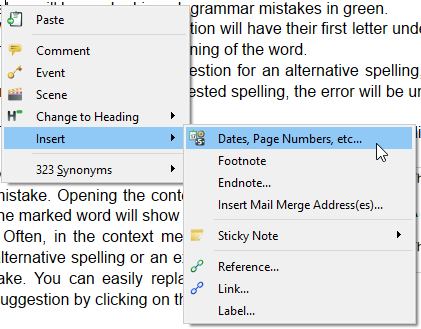Table of Contents
Main Menus
The main menus are located at the very top of the Papyrus Author window. These drop-down menus (e.g. File, Edit, etc.) are used to access the functions of Papyrus Author via dialogs and other windows. Basically, everything that can be enabled or changed in Papyrus Author can be found in these main menus.
The main menus are:
- File
- Edit
- View
- Insert
- Text
- Paragraph
- Document
- Author
- Options
- Guide
Dialogs
A dialog is a window, in which you can make changes to your settings.
Dialogs contain check boxes ![]()
![]() , with which you can select and deselect certain options, and radio buttons
, with which you can select and deselect certain options, and radio buttons ![]()
![]() , that allow you to choose from a list of options.
, that allow you to choose from a list of options.
In dialogs, you will also find other buttons that carry out various functions (for example ![]() ).
).
Most of the dialogs in Papyrus Author are non-modal, which means that they do not force you to complete a series of decisions before you can continue with your text. In essence, you can leave the dialog open while you continue working on your text and come back to the dialog when you are ready. Non-modal dialogs also allow you to try out a variety of settings without having to reopen the dialog each time.
In a non-modal dialog you can choose to either apply the settings and leave the dialog open, or you can apply the settings and close it.
The ![]() button will apply the settings you have chosen, but will not close the dialog.
button will apply the settings you have chosen, but will not close the dialog.
By selecting ![]() +
+ ![]() (Mac:
(Mac: ![]() +
+ ![]() ) you can apply the settings and close the dialog. This works just like hitting the
) you can apply the settings and close the dialog. This works just like hitting the ![]() button in other dialogs.
button in other dialogs.
The ![]() button will cancel all the settings you have just chosen and the
button will cancel all the settings you have just chosen and the ![]() button will revert all settings and close the dialog.
button will revert all settings and close the dialog.
You can choose which buttons you would like to see on your dialogs and what you would like them to do under “Preferences” → “User Interface” → “Dialog.”
Activate Buttons
For certain elements in the Papyrus Author dialogs there are special checkboxes that can check more options than just “on” or “off.”
With these “activate” buttons you can decide which settings within the dialog should be valid when you hit the ![]() button. Those that you do not select will remain inactive and will not be activated when you apply the settings.
button. Those that you do not select will remain inactive and will not be activated when you apply the settings.

An activate button
Other dialogs that make use of these activate buttons are “Table Properties,” “Spacing,” and “Microspacing.”

A tri-state checkbox
Close relatives of the “activate” buttons are the tri-state checkboxes. These types of checkboxes have three possible states (hence the name): they can be “on,” “off,” or “indeterminate”:
You can see an example of this on the right. When the checkbox is selected, the setting will be used when you click on ![]() . When the checkbox is not selected, the opposite of the setting will happen. If the checkbox is only colored in, the setting will not be used at all, meaning that everything controlled by this function will stay exactly the same in your document (only those options that are selected or deselected will change).
. When the checkbox is not selected, the opposite of the setting will happen. If the checkbox is only colored in, the setting will not be used at all, meaning that everything controlled by this function will stay exactly the same in your document (only those options that are selected or deselected will change).
The Context Menu
Making use of the context menu is a quick way to find the information you need.
“What should I do when I want to find something specific and aren’t sure where to look?”
“Right-click to open the context menu!”

The context menu with various options
The context menu is a pop-up menu, which, based on the context of the element you have right-clicked on, will give you a list of the most important options to choose from.
What will pop up depends on what you have clicked on–that is the context.
For example, Right-clicking on a graphic object will bring up options for colors, backgrounds, line style, etc. If you select a block of text, though, and right-click on it, you will see options for text style, operations for blocks of text, etc.
